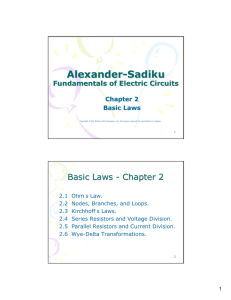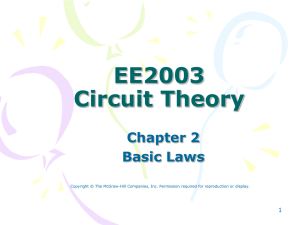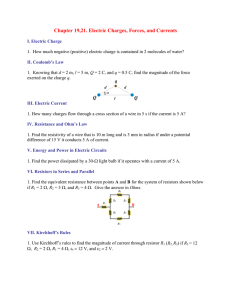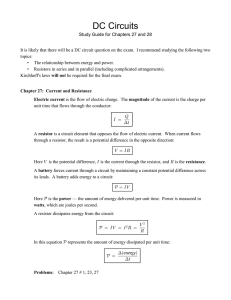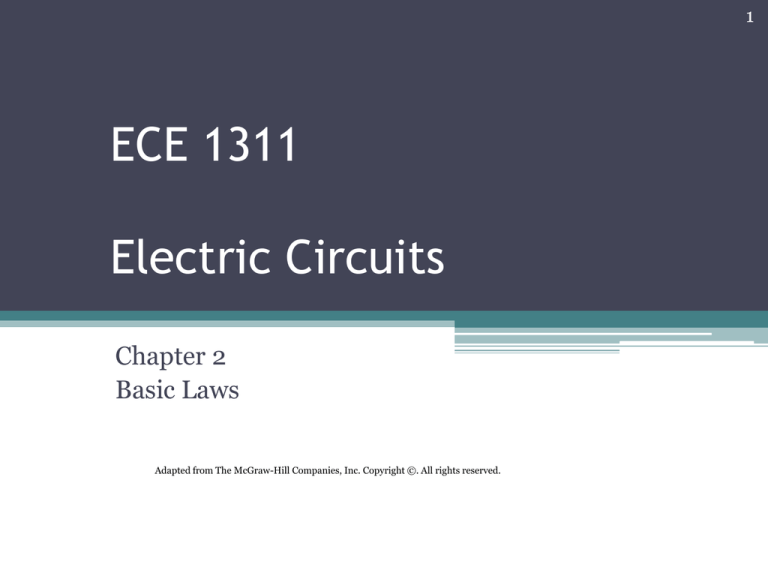
1
ECE 1311
Electric Circuits
Chapter 2
Basic Laws
Adapted from The McGraw-Hill Companies, Inc. Copyright ©. All rights reserved.
2
Basic Laws - Chapter 2
2.1
2.2
2.3
2.4
2.5
2.6
Ohm’s Law.
Nodes, Branches, and Loops.
Kirchhoff’s Laws.
Series Resistors and Voltage Division.
Parallel Resistors and Current Division.
Wye-Delta Transformations.
Supplementary lecture
on the derivation of R
2.1 Ohms Law (1)
• Ohm’s law states that the voltage across a
resistor is directly proportional to the current I
flowing through the resistor.
• Mathematical expression for Ohm’s Law is as
follows:
v iR
• Two extreme possible values of R:
0
(zero) and (infinite) are related with two
basic circuit concepts: short circuit and open
circuit.
4
2.1 Ohms Law (2)
• Conductance is the ability of an element to conduct
electric current; it is the reciprocal
of resistance R
and is measured in mhos or siemens.
1 i
G
R v
• The power dissipated by a resistor:
2
v
p vi i 2 R
R
5
6
2.2 Nodes, Branches and Loops (1)
• A branch represents a single element such as a voltage
source or a resistor.
• A node is the point of connection between two or more
branches.
• A loop is any closed path in a circuit.
• A network with b branches, n nodes, and l independent
loops will satisfy the fundamental theorem of network
topology:
b l n 1
2.2 Nodes, Branches and Loops (2)
Example 1
Original circuit
Equivalent circuit
How many branches, nodes and loops are there?
7
2.2 Nodes, Branches and Loops (3)
Example 2
Should we consider it as one
branch or two branches?
How many branches, nodes and loops are there?
8
2.3 Kirchhoff’s Laws (1)
• Kirchhoff’s current law (KCL) states that the algebraic
sum of currents entering a node (or a closed
boundary) is zero.
N
Mathematically,
i
n 1
n
0
9
2.3 Kirchhoff’s Laws (2)
Example 4
• Determine the current I for the circuit shown in the
figure below.
I + 4-(-3)-2 = 0
I = -5A
This indicates that the
actual current for I is
flowing
in the
opposite direction.
We can consider the whole
enclosed area as one “node”.
10
2.3 Kirchhoff’s Laws (3)
• Kirchhoff’s voltage law (KVL) states that the algebraic
sum of all voltages around a closed path (or loop) is
zero.
Mathematically,
M
v
m 1
n
0
11
2.3 Kirchhoff’s Laws (4)
Example 5
• Applying the KVL equation for the circuit of the figure
below.
va-v1-vb-v2-v3 = 0
V1 = IR1 v2 = IR2 v3 = IR3
va-vb = I(R1 + R2 + R3)
va vb
I
R1 R2 R3
12
13
2.4 Series Resistors and Voltage Division (1)
• Series: Two or more elements are in series if they are
cascaded or connected sequentially
and
consequently carry the same current.
• The equivalent resistance of any number of resistors
connected in a series is the sum of the individual
resistances.
N
Req R1 R2 RN Rn
1
• The voltage divider can be expressednas
Rn
vn
v
R1 R2 RN
2.4 Series Resistors and Voltage Division (1)
Example 3
10V and 5W are
in series
14
15
2.5 Parallel Resistors and Current Division (1)
• Parallel: Two or more elements are in parallel if they are
connected to the same two nodes and consequently have
the same voltage across them.
• The equivalent resistance of a circuit with
resistors in parallel is:
1
1
1
1
Req R1 R2
RN
N
• The total current i is shared by the resistors in inverse
proportion to their resistances. The current divider can
be expressed as:
v iReq
in
Rn
Rn
2.5 Parallel Resistors and Current Division (1)
Example 4
2W, 3W and 2A are
in parallel
16
17
2.6 Wye-Delta Transformations
Delta -> Wye
Wye -> Delta
Rb Rc
R1
( Ra Rb Rc )
Ra
R1 R2 R2 R3 R3 R1
R1
Rc Ra
R2
( Ra Rb Rc )
Rb
R1 R2 R2 R3 R3 R1
R2
Ra Rb
R3
( Ra Rb Rc )
Rc
R1 R2 R2 R3 R3 R1
R3
18



